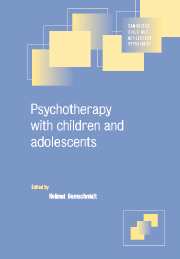Book contents
- Frontmatter
- Contents
- List of contributors
- Preface
- Part I Principles of psychotherapy with children, adolescents and families
- Part II Psychotherapeutic methods and settings
- Part III The practice of psychotherapy for specific disorders in childhood and adolescence
- 15 Anxiety disorders
- 16 Obsessive-compulsive disorder
- 17 Depressive syndromes and suicide
- 18 Dissociative [conversion] disorders
- 19 Disorders of sexual development and sexual behaviour
- 20 Substance abuse and addiction
- 21 Eating disorders
- 22 Psychotherapy in chronic physical disorders
- 23 Enuresis and faecal soiling
- 24 Dyslexia and dyscalculia
- 25 Stuttering
- 26 Hyperkinetic disorders
- 27 Autism
- 28 Schizophrenia
- 29 Conduct disorders, antisocial behaviour, delinquency
- 30 Physical abuse and neglect
- 31 Sexual abuse and sexual maltreatment
- Part IV The practice of psychotherapy in various settings
- Index
24 - Dyslexia and dyscalculia
- Frontmatter
- Contents
- List of contributors
- Preface
- Part I Principles of psychotherapy with children, adolescents and families
- Part II Psychotherapeutic methods and settings
- Part III The practice of psychotherapy for specific disorders in childhood and adolescence
- 15 Anxiety disorders
- 16 Obsessive-compulsive disorder
- 17 Depressive syndromes and suicide
- 18 Dissociative [conversion] disorders
- 19 Disorders of sexual development and sexual behaviour
- 20 Substance abuse and addiction
- 21 Eating disorders
- 22 Psychotherapy in chronic physical disorders
- 23 Enuresis and faecal soiling
- 24 Dyslexia and dyscalculia
- 25 Stuttering
- 26 Hyperkinetic disorders
- 27 Autism
- 28 Schizophrenia
- 29 Conduct disorders, antisocial behaviour, delinquency
- 30 Physical abuse and neglect
- 31 Sexual abuse and sexual maltreatment
- Part IV The practice of psychotherapy in various settings
- Index
Summary
Introduction
Dyslexia (also known as specific reading and spelling disorder) and dyscalculia (also known as specific disorder of arithmetical skills) influence performance at school to a great extent. Dyslexia usually leads to conflicts not only at school but also at home. Many additional psychological symptoms may occur, resulting sometimes in serious psychiatric disorders (Esser, 1990).
The many psychiatric and behavioural sequelae of dyslexia are generally of a ‘neurotic’ nature. Thus, symptoms arise as a result of conflicts between the desire to achieve at school, and the difficulty in fulfilling this expectation. Eventually, the child is unable to cope with the excessive demands and constant failure, and there is a resultant loss of self-esteem. Thus a vicious circle is established (Fig. 24.1), usually involving the school, parents and the peer group.
The conflicts I to IV in Fig. 24.1 directly affect the child. The child is less involved in conflict V, unless other children side with the dyslexic child in opposition to the school. Secondary symptoms are usually similar regardless of whether the child suffers from dyslexia or dyscalculia. Thus, the approach to treatment must be broad: after assessment and diagnosis, patients should be treated with a specific treatment programme aimed at their specific problem (reading, writing, arithmetic skills), but, in addition, individual psychotherapy may be required for any accompanying mental or behavioural symptoms (Skinner, 1998). Parents or families should be included in treatment, and in order to optimize results treatment programmes should be coordinated with the school.
Treatment of dyscalculia differs to some extent from the treatment of dyslexia in several points.
- Type
- Chapter
- Information
- Psychotherapy with Children and Adolescents , pp. 413 - 427Publisher: Cambridge University PressPrint publication year: 2001



